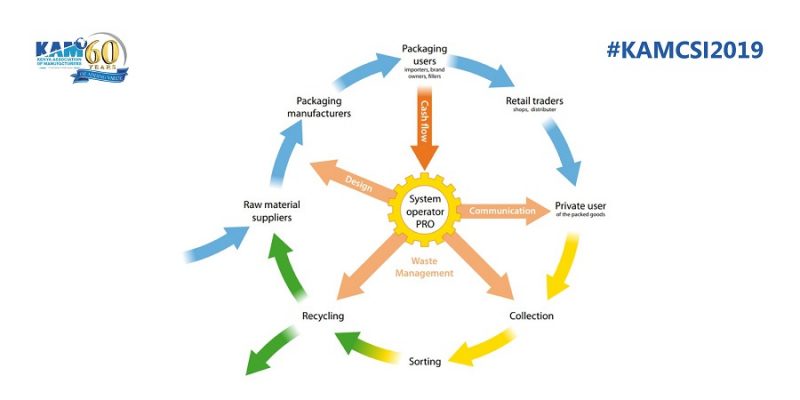Manufacturing and packaging industries in Kenya will be required to reduce pollution and environmental degradation from their products after use by consumers, according to proposed regulations.
Dr. Ayub Macharia, Director Environmental Education and Awareness in the Ministry of Environment and Forestry says the Environmental Management and Co-ordination (Extended Producer Responsibility) Regulations, 2020, will task “Every producer shall bear extended producer responsibility obligation to reduce pollution and environmental impacts of the product that they introduce in the market.”
According to Dr Ayub, this is one way to ensure sustainable use of natural resources, promotion of circular economy, reduction of waste at source, promote environmentally friendly products’ designs and packaging and cleaner production processes.
He was speaking during a virtual forum organized by the Bloggers Association of Kenya (BAKE) and the Kenya Association of Manufacturers (KAM) to discuss the expansion of the Centre for Energy Efficiency and Conservation (CEEC) to Centre for Green Growth and Climate Change (CGGCC).
The forum brought together KAM’s CEO Phyllis Wakiaga, the Director of Environmental Education and Awareness Dr. Ayub Macharia, Managing Director SIIAfrica Akshay Shah, and the PS for National Treasury Dr. Julius Muia.
“Sustainability is critical for industry’s growth and resilience,” Phyllis Wakiaga emphasised.
According to the association’s manufacturing Priority Agenda 2020 under pillar five – Industrial Sustainability and Resilience, advocates for green growth and sustainable development.
Wakiaga says the pillar calls for enhanced efforts to better manage solid waste to reduce the disposal of plastics as well as adopt use of clean energy sources.
Some of the actions they are embracing to promote green growth and sustainable development include the gradual reduction of dependency on thermal production to renewable energy production, localization and implementation of Sustainable Development Goal No. 12 on responsible production and consumption under the circular economy and the implementation of KAM’s Plastic Action Plan 2019.

Dr Ayub during the discussion disclosed that 60 percent of Kenya’s waste is organic, 35 percent is recyclable and only 5 percent that needs to be discarded. As a result, he said it was critical for industries to carry out annual audits and progress made on waste.
In addition, he said once the Sustainable Waste Management Bill, 2019 is enacted into law, it will be useful in establishing an appropriate legSet featured imageal and institutional framework for the efficient and sustainable management of waste in the framework of the green economy.
Kenya’s National Climate Change Action Plan also aims to strengthen the country’s path towards sustainable, climate-resilient development while achieving low carbon climate-resilient development in a manner that prioritises adaptation.
This is guided by the principles of Responsiveness, Equity and social inclusion, Consultation and cooperation, and fairness.
Akshay Shah explained how Silafrica, a leading packaging supplier to East Africa is moving from a linear to a Circular Economy.
In making circular products competitive, Wakiaga says, “That is a journey of transformation that needs to be deliberate…if we are able to raise awareness. A lot of green growth has challenges but lots of opportunities that require partnerships and collaborations…Green growth will be driven by partnerships and awareness to make the consumer conscience of their role.”
“We have to educate the public on how to think more about the products they purchase and how they can separate it effectively…Recycling waste makes us a better economy. Waste products need to have a functional value to the society,” Akshay Shah adds.
KAM”s Centre for Energy Efficiency and Conservation (CEEC) established in 2006 provides professional technical services for developing, designing and implementing energy efficiency projects to suit the needs of commercial, institutional and industrial consumers.
The main aim of the CEEC is to reduce costs and enhance competitiveness and profitability while promoting a clean and healthy environment.




